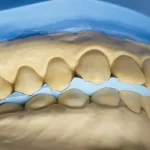3
Oct
From the practice to the laboratory: the importance of the dentist-technician relationship

Today, high-quality, modern dentistry must afford time and workflow optimisation, while maintaining an outstanding quality level.
For this to be possible, without burdening the organisational and economic dynamics of the practice, it is necessary to establish a flawless relationship between the clinical part and the dental laboratory part, i.e. the relationship between the dentist and the dental technician.
The first fundamental aspect to consider when talking about good cooperation between the two professionals is communication. (1)
The phases of practice-laboratory communication for the fabrication of restorations
Good communication ensures that restorations are well made, patients are satisfied and the dentist-technician relationship is straightforward. (1)
As shown by several studies, it is precisely communication that is the key to success in aesthetic dentistry and the relationship with the dental laboratory. (1-5)
If dental technicians had the patient in front of them, they could obtain a great deal of information on the soft tissues and lip movements, but also on the patient’s personality and aesthetic requirements.
Normally, however, this is not the case, because dental technicians do not have the opportunity to see patients in person. (1) It is therefore unlikely that this information can be obtained solely from the written prescription that dental technicians usually receive.
Written or digital prescription
Communication between the two professionals usually take place in written form. In routine practice, once they have taken an analogue or digital impression, dentists make a written or digital prescription, describing the type of restoration to be fabricated together with all the relevant characteristics and the delivery date. (1)
The impression, accompanied by the prescription, is sent to the dental laboratory, or is collected by the laboratory from the dental practice. The prescription form that reaches the laboratory should also state the type of disinfection that has been carried out on the impression.
Want to find out more?
Discover the importance of impression disinfection for preventing criticalities in dentistry
Unless particular problems come to light, the dental technician makes the restoration in the laboratory, on the basis of the instructions provided in the prescription, and sends it, so that it reaches the practice by the delivery date, which is often the day on which the restoration will be delivered to the patient. (1)
These steps do not always take place in a linear manner and can, therefore, entail various problems, such as missing, incomprehensible or incorrect information, or the mislaying of impressions or restorations during the logistical phases.
Errors during these communication phases are one of the biggest challenges of the dentist-dental technician relationship. (1,6,7)
The colour choice
Another common problem is the correct communication of the colour. The colour scale is still the method most commonly used by clinicians to communicate the colour chosen for the restoration. (8,9)
Nevertheless, communicating a colour does not simply mean transmitting a number, but a whole set of information concerning the colour, surface texture and particular characteristics of each tooth, such as cracks in the enamel, hypocalcified areas and translucency.
It is always a good idea to attach photographs to the prescription, to give the dental technician a better understanding of the patient’s aesthetics and specific characteristics. (10) It is also possible to explain to the dental technician the desired aesthetic colour management using a drawing showing any transparencies, opacities and other characteristics. (11)
Digital prescription transmission overcomes some of the existing problems and simplifies certain parts of the workflow. (1)
Knowledge of one another and of laboratory techniques
Another aspect that is detrimental to the relationship between the two professionals is poor knowledge of one another, as shown by a study published in 2009.
In particular, this study showed that dentists, particularly recently trained ones, are poorly acquainted with dental laboratory techniques. This gap makes communication ineffective, resulting in a sub-optimum working relationship. (12)
A dentist with a good knowledge of dental laboratory techniques will be able to foresee, and therefore provide, all the information the dental technician requires to carry out the work. If this is not the case, communication and the relationship become non-linear, leading to problems and delays, which are economically and organisationally detrimental to both the dentist and the dental technician.
The patient’s level of satisfaction and trust also decrease when there are delays compared to the initially proposed timeline.
Conclusions
In the light of these aspects, it goes without saying that it is essential to optimise the relationship between the dentist and dental technician through the acquisition of a solid theoretical base, clean and effective communication, and the sharing of certain clinical and dental laboratory protocols.
References
- Alshiddi, I. F. (2014). Communication between dental office and dental laboratory: From paper-based to web-based. Pakistan oral & dental journal, 34(3).
- Davenport JC, Basker RM, Heath JR, Ralph JP, Glantz P-O, Hammond P. A. Clinical guide to removable partial denture design. 2nd ed. London: British Dental Association; 2000.
- Pietrobon N, Malament KA. Team approach between prosthodontics and dental technology. Eur J Esthet Dent. 2007;2(1):58–79.
- Lynch CD, McConnell RJ, Allen PF. Trends in indirect dentistry: 7. Communicating design features for fixed and removable prostheses. Dent Updat. 2005;32(9):502–510.
- Materdomini D. Communicate visually with your laboratory. J Am Acad Cosmet Dent. 1994;1:32–34.
- Christensen GJ. Improving dentist-technician interaction and communication. J Am Dent Assoc. Am Dental Assoc. 2009;140(4):475.
- Drago CJ. Clinical and laboratory parameters in fixed prosthodontic treatment. J Prosthet Dent. 1996;76(3):233–238.
- Derbabian K, Marzola R, Arcidiacono A. The science of communicating the art of dentistry. J Calif Dent Assoc. 1998 Feb;26(2):101-106.
- Touati B, Miara P, Nathanson D. Esthetic dentistry and ceramic restorations. London: Martin Dunitz Ltd; 1999.
- Marcucci B. A shade selection technique. J Prosthet Dent. 2003;89(5):518–521.
- Sorensen JA, Torres TJ. Improved color matching of metal ceramic restorations. Part II: Procedures for visual communication. J Prosthet Dent. 1987;58(6):669–677.
- Juszczyk, A. S., Clark, R. K. F., & Radford, D. R. (2009). UK dental laboratory technicians’ views on the efficacy and teaching of clinical-laboratory communication. British dental journal, 206(10), E21-E21.
Do you want more information on Zhermack Dental products and solutions?
Contact us




 Zhermack SpA has been one of the most important producers and international distributors of alginates, gypsums and silicone compounds for the dental sector for over 40 years. It has also developed solutions for the industrial and wellbeing sectors.
Zhermack SpA - Via Bovazecchino, 100 - 45021 Badia Polesine (RO), Italy.
Zhermack SpA has been one of the most important producers and international distributors of alginates, gypsums and silicone compounds for the dental sector for over 40 years. It has also developed solutions for the industrial and wellbeing sectors.
Zhermack SpA - Via Bovazecchino, 100 - 45021 Badia Polesine (RO), Italy.


